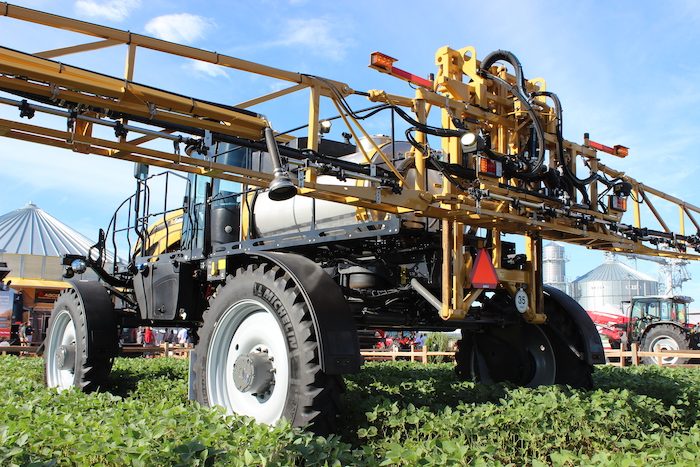Editor’s Note: This Q&A originally appeared in AG Tire Talk to provide answers that farm equipment dealers have about farm tire technology. This series features a trending question followed by an abridged version of the answers. For the complete answers, check out www.agtiretalk.com.
QUESTION: In sprayer applications, what is your recommendation to improve driver comfort and reduce road lope?
Bradley Harris, Manager of Global Agricultural Field Engineering, Firestone Ag Division, Bridgestone Americas Tire Operations LLC
With the high center of gravity of high clearance sprayers, operators tend to feel more roll and sway of the vehicle compared to a tractor. This feeling is amplified when narrow tires are installed and the vehicle is transported down the road with half a tank of liquid. Firestone Ag recommends to all customers to follow these guidelines:
Use the appropriate section width tire on the machine. When the machine is not in the field with a current crop, purchase and use the OE-approved flotation tire with a width of 520mm (20.8 inches) to 800mm (30.5 inches).
Use IF or VF tires. IF- and VF-marked tires carry more load at the same inflation pressure as the same-sized standard radial tire.
Tender the sprayer at the field. Don’t travel down the road with product in the tank.
Road lope occurs when the wheel assemblies have a high and low spot. When changing tires on these machines, it becomes important to make sure the tire/wheel assemblies are concentric — centered on the centerline of the axle — to prevent road lope.
Norberto Herbener, OE Applications Engineer, Mitas Tires North America Inc.
Road lope is produced when equipment bounces during transport, forcing the driver to reduce speed. Tire quality, design, and incorrect end user usage are a few causes of road lope. There are many solutions to solve the issue.
Tire technology has evolved at a rapid pace, changing the mindset of tires being a “black doughnut” to a complex and fundamental part of equipment. As agriculture equipment has grown over the years in size and weight, users have requested a larger footprint for less compaction to protect their farm land. This has also been a trend for sprayer users to request width options to minimize damage to the standing crop. As a solution to this issue, VF (Very Flexible) technology was introduced and allows for an increase of 40% on the load capacity at same pressure and speed or a 40% reduction in inflation pressure at same load and speed.
As we know, the load capacity of a tire is dominated by the volume of air in the tire. The more air at higher inflation pressure, the higher the load carrying capacity. This is the reason why sprayer tires have been evolving not only to incorporate VF technology, but also to introduce higher aspect ratios, for example the 380/105R50, keeping the same width and rim size but higher load capacity. This characteristic, combined with very flexible side walls increases the contact area and ride comfort.
In summary, the best way to resolve the issue of road lope is to ensure use of the correct inflation pressure.
James Crouch, Marketing Specialist, Alliance Tire Americas Inc.
A smooth, comfortable ride is better for sprayer operators in two important ways. On an immediate level, it reduces driver fatigue, which helps keep their reflexes sharp and their driving safe. And a machine that doesn’t shimmy or bounce down the road is much easier to control, which helps keep everybody safer.
On a longer-term level, studies of equipment operators in other industries have found that oscillations at 4 to 8 vibrations per second transmitted by machinery from the ground surface can be amplified by the driver’s body, which can cause back and joint pain. High-amplitude shocks — like a jolt from hitting a rut in the field — can also contribute to injury and strain.
At the Alliance Tire Group Inc., we’re addressing ride quality and rode lope sprayers in several ways with our Alliance Agriflex+ 363 VF row-crop tire. First, the block-style tread pattern is optimized for a smooth, stable ride on the road because we recognize that half of a sprayer operator’s time can be spent on pavement or gravel, getting from field to field and back to the loading pad. The heavy center rib, evenly distributed tread patch and sharp shoulders run smoothly over the road while still delivering traction and self-cleaning in the field; they also reduce tire wear and minimize heat build-up for longer performance.
Just as important as the tread pattern, the 363’s VF sidewall also minimizes both high-frequency and high-amplitude vibration. The flexibility of the sidewall is a natural damper, and the 363’s extended bead filler directs more force to the sidewall where it can be absorbed.
Road lope is also a comfort, safety and fatigue factor. One thing you can do to minimize road lope is make sure you’re operating at the proper tire pressure.
David Graden, Ag Sales & Development Manager, Michelin North America Inc.
Michelin’s patented VF Ultraflex Sidewall Technology allows the Spraybib to perform at ultra-low air pressures while carrying the same weight as standard tires. Lower air pressure provides superior driver comfort, a much longer footprint for greater traction, and the ability to handle exceptional load capacity ranging from 173/14,330 lbs. load range to 179/17,086 lbs. load range at up to 40 mph.
As for road lope, if the air pressure is properly set with regard to the maximum loaded weight of the machine, it is a non-issue. All Michelin agriculture representatives carry a set of two scales to provide customers peace of mind, knowing their air pressures are correct and tires are adequate for the application. Additionally, the practice of dialing in air pressures to the machine and application will boost overall performance by optimizing footprint, traction, rider comfort, reducing fuel consumption, improving wear, and overall control of the machine.
Dave Paulk, Manager of Field Technical Services, BKT USA Inc.
There are several factors that will cause road lope and ride discomfort in sprayers. Sprayers have a high center of gravity, can run at speeds of up to 40 mph, and are heavy, especially when hauling liquid. It is always advisable to use IF and VF tires when running the narrower cross section tires.
The IF will carry 20% more weight at the same air pressure as a standard tire. The VF will carry 40% more weight at the same air pressure as a standard tire. This will give the sprayer the proper weight carrying capacity for the tires, and minimize the tires squirming while transporting. It is best to transport the sprayer empty and fill the tanks at the field. The liquid sloshing in the tank while transporting can make the sprayer hard to handle and difficult to stop.
Correct air pressure settings are important for a good ride, minimizing ride discomfort, and ensuring that the tires will carry the load. Add the weight of the machine to the weight capacity of the tanks to get a maximum weight that the tires will have to carry. Set air pressures accordingly to the total weight the tires need to carry. It is best to weigh the sprayer fully loaded for accuracy if scales are available. It is important to periodically check air pressures in the tires to ensure that they have the correct amount of air to carry the weights that are demanded of the tires. Since tire liners are not 100% air tight, air loss will occur over time. Ambient air temperature also effects air pressure.
Road lope can be caused by tires that feel “out of round.” Generally, this is caused by the high and low spots on the tires and wheels not being matched up. No wheel or tire is perfectly round. Both have high and low spots. The high spot on the tire needs to be matched with the low spot on the wheel, or vice versa. If this problem exists, the tire can be deflated, and turned on the wheel 180 degrees to try to remedy this issue.
Scott Sloan, Ag Product manager/Global LSW, Titan International Inc.
There are numerous theories as how to improve driver comfort in self-propelled sprayers. If you think about the application, you have an operator sitting 10 ft. in the air on a machine that could weigh close to 50,000 lbs., attempting to travel hundreds of miles on four tires typically no wider that 15 inches inflated to 78 psi in most cases, at 35 mph. That is a challenge.
The first thought is to drop inflation pressures. With advent of IF and VF technologies, the tire industry has allowed higher deflections, 20% and 40% more, which naturally creates a “softer” ride. Although in many cases the lower inflation does soften the ride, it may create more issues of road lope. In addition, the increased deflection creates a reduction of lateral stability on the machine. The operator may feel uncomfortable with the “squirm” and instability of the machine when traveling not only on the road but in hillier conditions in the field. There have been reports of VF tires rolling off the rim in these conditions.
Titan’s LSW technology in sprayer applications addresses both of these issues. Lower inflation pressures for ride comfort combined with the lower sidewall (see graphic) reduces loping and increases lateral stability, whether it be in a float option like our LSW650/60R42 replacing the 650/65R38 or the LSW380/75R50 replacing the standard 380/90R46.







